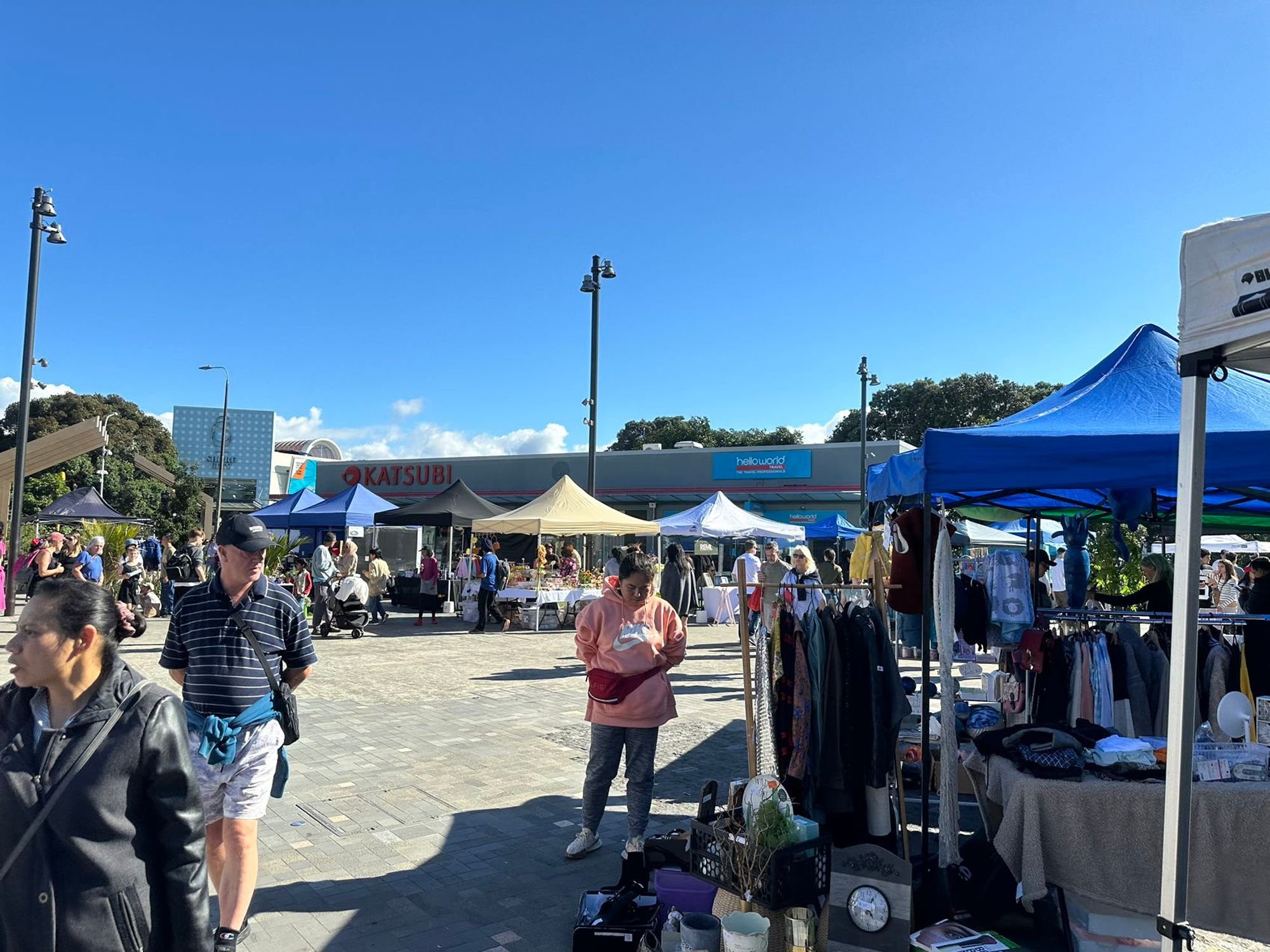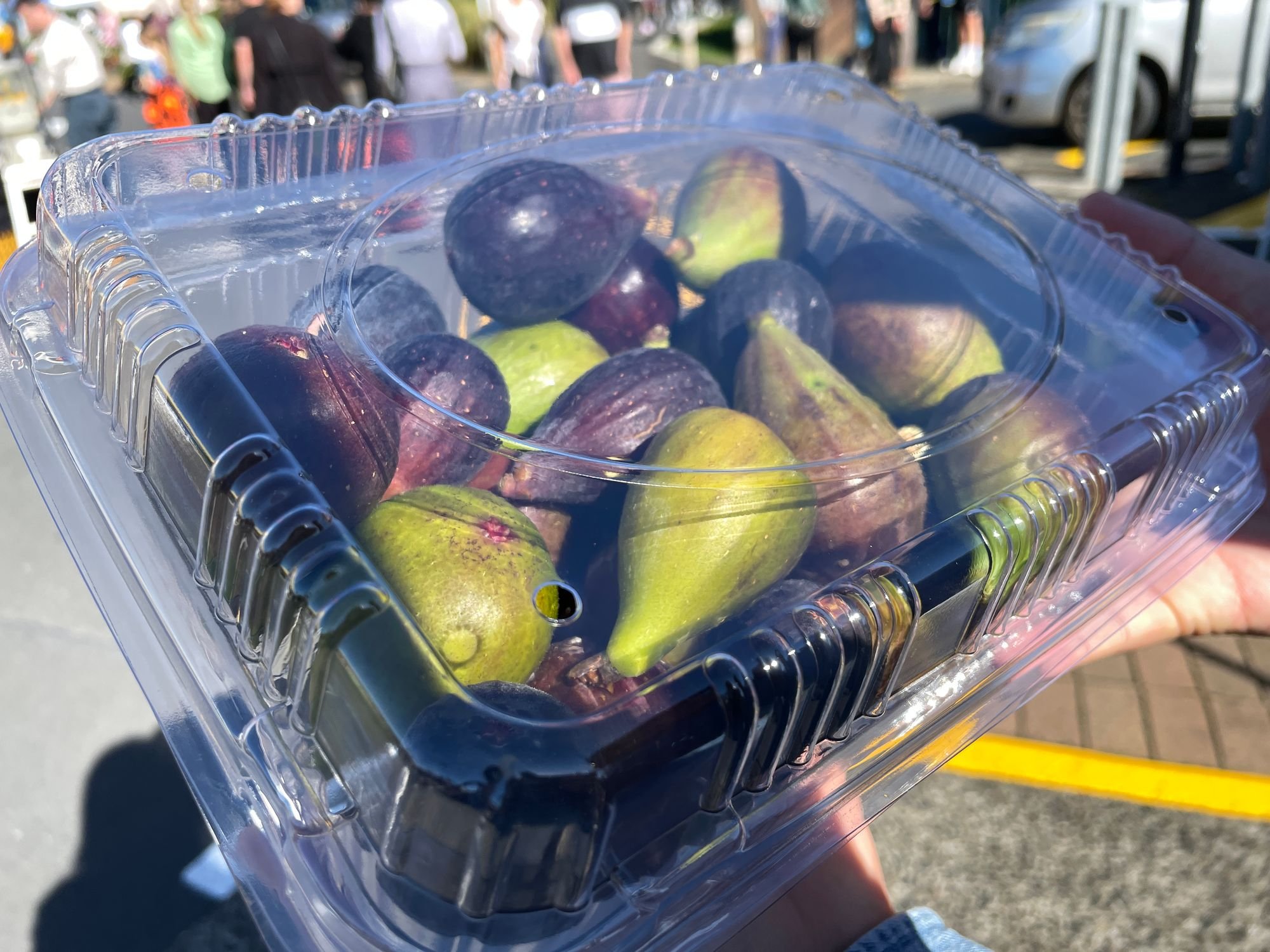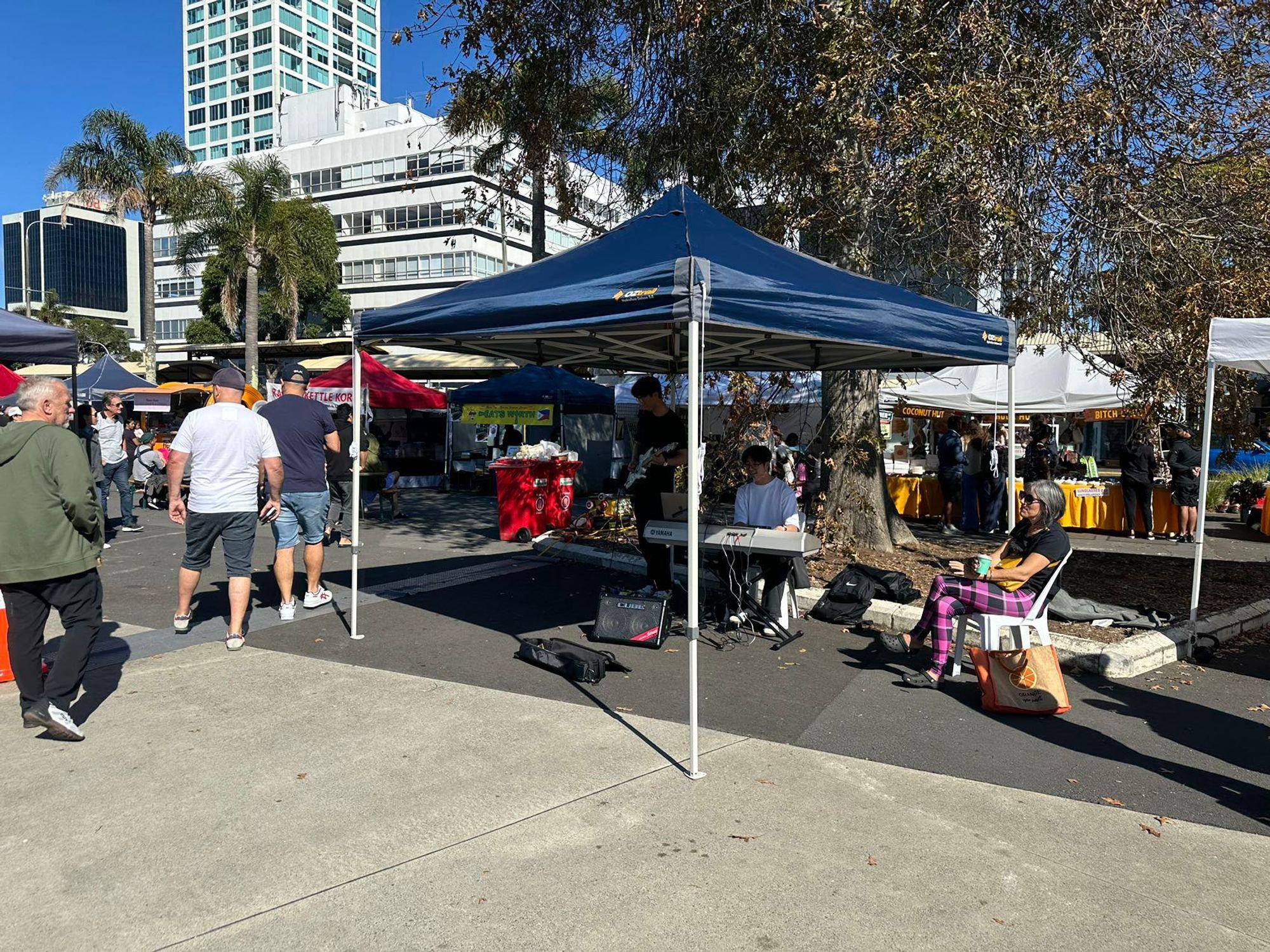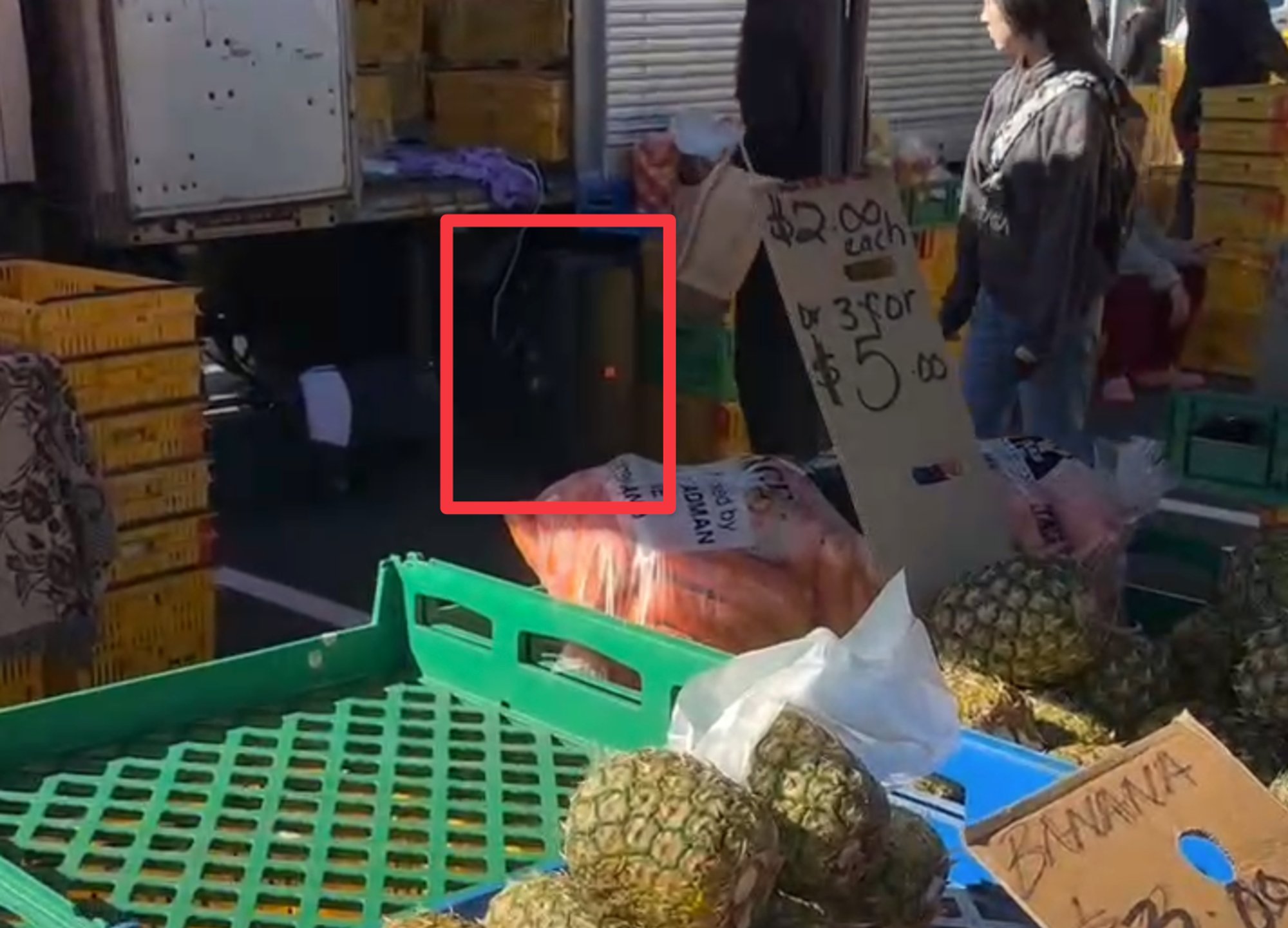 web3.0
web3.0
 How to prevent public goods from being 'freely procured'? While visiting the weekend market, I thought of these four points
How to prevent public goods from being 'freely procured'? While visiting the weekend market, I thought of these four points
How to prevent public goods from being 'freely procured'? While visiting the weekend market, I thought of these four points
Related concepts of popular science public goods - taking weekend markets as an example
First of all, weekend markets are markets held in a square or parking lot on weekends. Vendors can apply for stalls and pay a certain amount of rent to set up. stall, and then everyone can come and visit. Some sell food, some sell flowers or handmade products, and some come to play music. It probably looks like this:

#The market place is the so-called commons, that is, it is a public place where everyone can come and play and enjoy the commons. these activities and products.
On this common land, there is competition and exclusivity among the stalls selling goods, especially among the stalls selling breakfast. Because a person's appetite is limited, if he eats a hot dog, he is unlikely to eat a basket of steamed dumplings. This is competition. Among the limited number of tourists, the more people eat my food, the more I earn.
When specific things are bought by others, they become exclusivity. If a product is sold to buyer A, it cannot be sold to buyer B. Similarly, merchants also have the ability to control whether to sell to a certain type of people. This is called exclusivity. When I went, it was a little late, so the good figs had already been picked out.

On this piece of public land, there is another type of stall that is both non-excludable and non-competitive, which is the so-called public good. Yes, this scene at the weekend market is filled with stalls playing music.

Non-exclusiveness is reflected in:
1) You don’t need to pay to listen to the music.
2) The music performer cannot let the designated people on the scene hear the music and exclude some people.
Non-competitiveness is reflected in:
1) You can listen to music whether you have had breakfast or purchased a product.
2) There are multiple stalls playing music on site, and no one will refuse to listen to another one just because of this sound.
The main profit model of this music stall relies on donations, that is, a guitar bag is placed in front of it. If you think it sounds good, you can donate money voluntarily.
However, this model has relatively large uncertainties and persistence.
Assuming that the donated money is not enough to make a living, then people may not be able to continue to choose to make music, and then there will be no music in this common land.
This is also another dimension of the tragedy of the commons, that is, the lack of good support for valuable public goods leads to damage to the entire ecology.
Here, we have an assumption that the music is better than noise. Music can bring pleasant emotional value to people at the scene, which may attract more people to the area or make consumption decisions easier.
Based on this assumption, stalls near music stalls may have more customer flow and turnover. But these stalls will not donate to this music stall. This is the so-called free riding, which means that people tend to use public resources for free.
So far, the concepts of public goods, tragedy of the commons, free riding, competition, and exclusivity have been explained. One more thing to say is that it is difficult to have absolute public goods. For example, you cannot hear this music outside this square. It is exclusive from the geographical point of view, so the judgment of public goods is usually based on relative degree under certain conditions.
How to continuously maintain valuable public goods
How to identify and measure the value of public goods?
First of all, most people recognize the value of public goods. After all, everyone can benefit from it without paying actual costs. Free prostitution is really good. This extends to the first question: How to identify and measure the value of public goods?
For commodities, it is very easy to achieve this. I spent money to buy a loaf of bread and was full. This was a real benefit.
But for music, I feel happy after listening to it. How can I measure it with money? This is a big public goods issue. For example, for some publicly accessible papers, many people may not be able to understand them, so they are worthless. It is also possible that a certain research was conducted based on them, and a brand new technology was developed and changed mankind.
So how to price this paper? Patents are a way to protect intellectual property, but they are also a restriction. Lawsuits and laws surrounding patents consume a lot of resources in human society and also restrict the development of some technologies.
If all research results were completely open public goods, would the world be different? This is a topic of DeSci’s decentralized science research.
If a public good has a clear value, things will be easier to handle. For example, inviting a band to the scene can increase the booth management fee by 1,000 dollars, then the booth manager will be able to pay 600 dollars to the band to come here. Weekend Plaza. But in fact we cannot measure it, so our discussion below is based on the premise that public goods are valuable.
How to achieve the sustainability of public goods?
Take this music stall as an example. As a public good, how can it achieve sustainability? There are several options below:
Donate.
# If the performance is good, everyone will consider donating if they feel happy. This is also the most direct and simple way to provide public goods, but the funds are usually very small because everyone likes to do it for free. This is a typical tragedy of the commons.
This type of solution in Web3 includes Gitcoin, GiveETH, JuiceBox, Donate3 (LXDAO), etc. Optimize donation process and transparency through blockchain technology.
Learn about Donate3: https://lxdao.io/projects/006
The venue operator pays the fee.
If it is verified that a market must have music, then the operator will support stalls that are more difficult to make profits but are necessary by charging stall fees and profits from other stalls.
This is the current tax mechanism, which allocates tax revenue to public goods such as infrastructure construction, school and education construction.
New distribution mechanism
If the output and value of public goods can be quantified, - it can prove that music Stalls can increase the turnover of surrounding stalls, so the benefited stalls should pay a certain fee to the music stalls to achieve a fair distribution of profits.
In Web3, this method is still in the research and exploration stage, but it is expected to achieve fair and effective resource reallocation.
Commercialization
For example, setting up a paid song request service, selling related products, or hanging advertisements on booths.
Another approach is to share some operating costs by partnering with commercially profitable stalls. For example, in the fruit stall below, the stall owner uses a speaker to play music (red box in the picture below) to attract customers and at the same time provide music as a public good. Music stalls only need to pay electricity bills for cooperative stalls.
This point has been discovered in Web3. Some new funds have been established one after another, promising to invest part of the investment profits in supporting public goods. This may affect everyone’s experience during commercialization, so Vitalik created the concept of “evil-income curve” (more on that another day).
Evil-Income Curve——https://vitalik.eth.limo/general/2022/10/28/revenue_evil.html

Why we need to pay attention to the sustainability of public goods
Public goods are everywhere
It seems difficult to solve, the sustainability of public goods Does sex have anything to do with me? Or do we really need public goods?
In fact, the problem of public goods does not only occur at weekend markets or in one region or country, but everywhere. You may not go to weekend markets, but I believe you must surf the Internet every day. The Internet, a commons, is filled with countless public goods and non-public goods. Are you willing to accept an Internet like the following:
Logging in to any website to view information or download materials requires a paid subscription.
You need to pay some fee to use almost all software, and there are not many free software available.
Even though this software and website are free, they are full of ads that pop up every time you click on them.
Commercial companies can exclusively restrict whether I can use their services, even if I am willing to pay. There are no competing products for free open source software, and commercial companies charge sky-high prices.
The reason why you can enjoy the existing free, open, and shared Internet to a certain extent is because of the existence of open source projects and digital public goods.
Open source contributors and public goods builders deserve appreciation
Why do these open source contributors and public goods builders deserve appreciation?
It’s because they are not afraid of the tragedy of the commons and are willing to contribute without asking for anything in return. Just imagine how many people come to the weekend market and are willing to help clean and maintain the public environment for free?
Open source projects and digital public goods have faced such huge challenges, but still helped create such an open and free Internet, thus accelerating the development and historical process of all mankind.
Reverse thinking, if we increase our attention, publicity, and support for public goods, or even personally participate in the construction of these public goods, donate a little money or participate in the development and maintenance of some open source projects, once some possible issues are solved, The question of sustainability: What will the world look like if public goods are as sustainable as private goods and commerce?
What we are doing
As one of the co-founders of LXDAO, I have been committed to exploring the sustainability issues of digital public goods and open source projects in the past two years, and providing related public services.
Web3 technology and concepts provide me with hope of solving these problems. For example, the borderless nature of cryptocurrencies allows for automated programmatic payments, making it possible to automate open source funding on a global scale; NFTs can solve the problem of ownership of digital public goods. The open source nature of Web3 has also given digital public goods a new voice (especially in the Ethereum ecosystem); the DAO's operating model naturally fits the collaborative nature of open source projects, allowing people to submit code remotely and anonymously while receiving funding from the DAO.
The above is the detailed content of How to prevent public goods from being 'freely procured'? While visiting the weekend market, I thought of these four points. For more information, please follow other related articles on the PHP Chinese website!

Hot AI Tools

Undresser.AI Undress
AI-powered app for creating realistic nude photos

AI Clothes Remover
Online AI tool for removing clothes from photos.

Undress AI Tool
Undress images for free

Clothoff.io
AI clothes remover

Video Face Swap
Swap faces in any video effortlessly with our completely free AI face swap tool!

Hot Article

Hot Tools

Notepad++7.3.1
Easy-to-use and free code editor

SublimeText3 Chinese version
Chinese version, very easy to use

Zend Studio 13.0.1
Powerful PHP integrated development environment

Dreamweaver CS6
Visual web development tools

SublimeText3 Mac version
God-level code editing software (SublimeText3)

Hot Topics
 1387
1387
 52
52
 What are the advantages of Bijie.com's layout of crypto finance and AaaS services?
Apr 21, 2025 am 10:51 AM
What are the advantages of Bijie.com's layout of crypto finance and AaaS services?
Apr 21, 2025 am 10:51 AM
The advantages of Bijie.com in the fields of crypto finance and AaaS business include: 1. Crypto finance: ① Professional investment and research team, ② high-quality content ecology, ③ secure platform guarantee, and ④ rich product services. 2. AaaS business areas: ①Technical innovation capabilities, ②Data advantages, ③User base and demand insights.
 Gate.io Sesame Open Exchange Tips for Buying and Selling Coins (Guide to Novice)
Apr 21, 2025 am 11:51 AM
Gate.io Sesame Open Exchange Tips for Buying and Selling Coins (Guide to Novice)
Apr 21, 2025 am 11:51 AM
Tips for buying and selling coins on Gate.io include: 1. Make research plans before buying coins to understand the market and risks; 2. Choose trading pairs with high liquidity such as BTC/USDT; 3. Use limit orders to control the buying cost; 4. Pay attention to market trends and analyze price trends; 5. Set stop-profit and stop-loss when selling coins, and manage risks; 6. Use batch selling strategies to balance returns and risks; 7. Combine market sentiment and judge the selling timing; 8. Pay attention to macroeconomic and policy changes, and adjust strategies in a timely manner.
 How to avoid losses after ETH upgrade
Apr 21, 2025 am 10:03 AM
How to avoid losses after ETH upgrade
Apr 21, 2025 am 10:03 AM
After ETH upgrade, novices should adopt the following strategies to avoid losses: 1. Do their homework and understand the basic knowledge and upgrade content of ETH; 2. Control positions, test the waters in small amounts and diversify investment; 3. Make a trading plan, clarify goals and set stop loss points; 4. Profil rationally and avoid emotional decision-making; 5. Choose a formal and reliable trading platform; 6. Consider long-term holding to avoid the impact of short-term fluctuations.
 Binance officially announced: On April 11, the collateral rate of multiple cryptocurrencies will be adjusted again
Apr 21, 2025 am 11:21 AM
Binance officially announced: On April 11, the collateral rate of multiple cryptocurrencies will be adjusted again
Apr 21, 2025 am 11:21 AM
Binance has adjusted the collateral ratio of several assets, involving FLOW, COMP, etc., which has generally declined. 1. FLOW and COMP have been reduced from 80% to 70%. 2. 1INCH dropped from 70% to 65%. The move is designed to manage risks and ensure market stability, and investors need to adjust their positions to cope with increased margin requirements and potential forced closing risks.
 A list of top 10 global leading virtual currency trading apps in 2025
Apr 21, 2025 pm 12:06 PM
A list of top 10 global leading virtual currency trading apps in 2025
Apr 21, 2025 pm 12:06 PM
The top ten leading virtual currency trading apps in the world in 2025 are: 1. Binance, 2. Gate.io, 3. OKX, 4. Huobi Global, 5. Bybit, 6. Kraken, 7. FTX, 8. KuCoin, 9. Coinbase, 10. Crypto.com.
 What are the top ten platforms in the currency exchange circle?
Apr 21, 2025 pm 12:21 PM
What are the top ten platforms in the currency exchange circle?
Apr 21, 2025 pm 12:21 PM
The top exchanges include: 1. Binance, the world's largest trading volume, supports 600 currencies, and the spot handling fee is 0.1%; 2. OKX, a balanced platform, supports 708 trading pairs, and the perpetual contract handling fee is 0.05%; 3. Gate.io, covers 2700 small currencies, and the spot handling fee is 0.1%-0.3%; 4. Coinbase, the US compliance benchmark, the spot handling fee is 0.5%; 5. Kraken, the top security, and regular reserve audit.
 Keep up with the pace of Coinjie.com: What is the investment prospect of crypto finance and AaaS business
Apr 21, 2025 am 10:42 AM
Keep up with the pace of Coinjie.com: What is the investment prospect of crypto finance and AaaS business
Apr 21, 2025 am 10:42 AM
The investment prospects of crypto finance and AaaS businesses are analyzed as follows: 1. Opportunities of crypto finance include market size growth, gradual clear regulation and expansion of application scenarios, but face market volatility and technical security challenges. 2. The opportunities of AaaS business lie in the promotion of technological innovation, data value mining and rich application scenarios, but the challenges include technical complexity and market acceptance.
 Web3 trading platform ranking_Web3 global exchanges top ten summary
Apr 21, 2025 am 10:45 AM
Web3 trading platform ranking_Web3 global exchanges top ten summary
Apr 21, 2025 am 10:45 AM
Binance is the overlord of the global digital asset trading ecosystem, and its characteristics include: 1. The average daily trading volume exceeds $150 billion, supports 500 trading pairs, covering 98% of mainstream currencies; 2. The innovation matrix covers the derivatives market, Web3 layout and education system; 3. The technical advantages are millisecond matching engines, with peak processing volumes of 1.4 million transactions per second; 4. Compliance progress holds 15-country licenses and establishes compliant entities in Europe and the United States.


